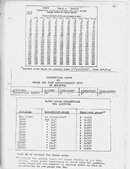I mentioned above that the capillary gauge automatically corrected for altitude. The reason is that the capillary gauge will read deep. If you look at the table below, which I copied from various sources in the mid-1970s, you can see that at 4000 feet (about 1200 meters) the capillary gauge reading needs to be multiplied by 0.887 to get the true depth. So if I'm diving a lake at 4000 feet altitude, and my capillary gauge reads 30 meters (98.43 feet), I would log in my dive log 30 meters, then to correct it I would have to do the following calculation:
30 meters x 0.887 = 26.6 meters actual depth
or:
98.43 feet x 0.887 = 87.3 feet actual depth
But if I were using the U.S. Navy Diving Tables, which show for 100 feet a NDL of 25 minutes. But if we used the actual depth of 87.3 feet, the NDL would be 30 minutes.
If we used an accurate oil-filled Bounden tube depth gauge, we would need to add 4.7 feet to the depth reading, and then add a 3% correction factor. So if we were at 30 meters (98.43 feet) we would need to add 1.4 meters (4.7feet) to that reading, for 31.4 meters (99.83 feet), plus 3% for a depth of 34.3 meters (102.3 feet) depth. Note, that this would put the NDL higher, at 110 feet for 20 minutes using the U.S. Navy Diving Tables.
In the 1970s, we only had what was on this sheet for calculating altitude corrections. The Cross Tables for "Theoretical Depth at Altitude for Given Actual Diving Depth in Fresh Water" was a set of tables developed by E.R. Cross. If we had a line-measured depth, or a depth with correction using a depth gauge, we could use this table to determine which depth to use with the U.S. Navy Diving Tables. For instance, at 4000 feet altitude, we could dive to 100 feet, but would be best to use 116 feet as the "theoretical depth" for calculating NDLs or decompression. Table is quite out-dated, and should not be used currently, but I wanted you to see it to see how, in the past, we coped with altitude.
SeaRat
http://www.usu.edu/scuba/navy_manual6.pdf




